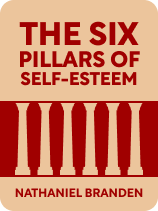

This article is an excerpt from the Shortform book guide to "The Six Pillars of Self-Esteem" by Nathaniel Branden. Shortform has the world's best summaries and analyses of books you should be reading.
Like this article? Sign up for a free trial here .
Is Nathaniel Branden’s The Six Pillars of Self-Esteem worth reading? How did readers rate the book?
In The Six Pillars of Self-Esteem, psychotherapist Nathaniel Branden challenges the prevailing assumption that self-esteem is unconditional love for yourself. Instead, he argues that your self-esteem depends on your behavior—and that only by behaving according to certain tenets, or pillars, can you improve your self-esteem. He also examines the role external influences play on your self-esteem and how you can influence others’ self-esteem with the right behaviors.
Keep reading for The Six Pillars of Self-Esteem review and commentary.
About the Author
Nathaniel Branden was a psychotherapist who dedicated his life to examining how self-esteem affects our daily lives, writing almost 20 books on the topic. As a result, Branden is known to many as “the father of self-esteem.” However, Branden was perhaps best-known for his relationship with philosopher Ayn Rand. Although the pair had a famous falling out in the late 1960s, Branden initially gained fame as her collaborator and was also her lover for some time. Branden’s initial work on self-esteem was heavily influenced by Rand’s ideas, and much of the material in his first book, The Psychology of Self-Esteem, was first published in a magazine they co-edited.
Branden passed away in 2014 at the age of 84.
Connect with Nathaniel Branden’s Work:
The Book’s Publication and Context
Publisher: Bantam
Published in 1994, The Six Pillars of Self-Esteem is Branden’s 14th book and his 11th on self-esteem. It builds on several ideas Branden discussed in previous works but is considered by its publishers as Branden’s “definitive book on the subject.” Notably, Branden’s first book on self-esteem, The Psychology of Self-Esteem, provides the philosophical underpinnings for what Six Pillars defines as self-esteem. Additionally, Branden first introduced several of the pillars, or behaviors he recommends for improving self-esteem, in How to Raise Your Self-Esteem (1987).
Historical and Intellectual Context
As noted in his introduction, Branden wrote Six Pillars as a criticism of the self-esteem movement of the late 1980s and early 1990s. In the mid-1980s, California politician John Vasconcellos discovered scientific research that correlated low self-esteem with various psychological issues. As a result, Vasconcellos came to believe that improving self-esteem could reduce various psychological and social issues—and in 1986, California created a state task force devoted to discovering how that might be.
This task force captured the attention of national media—first as a joke, then as a serious endeavor after University of California researchers confirmed a correlation between low self-esteem and social issues. This research, coupled with the task force’s publication of reports that highlighted how self-esteem improves practically everything—from your grades to your health to whether you follow the law—began a self-esteem craze that swept the nation: Companies, schools, and the government began creating programs focused on combating various issues by improving individuals’ self-esteem.
While Branden agreed with the premise that improving individuals’ self-esteem would reduce social issues, his disagreement with popular beliefs about how to raise self-esteem led him to write Six Pillars. His emphasis on self-esteem founded in your behavior stood out amongst a sea of texts touting self-esteem as love for yourself no matter what.
Critical Reception
Positive The Six Pillars of Self-Esteem reviews praised Branden’s philosophy of self-esteem and the actionable exercises in the book. However, many found Branden’s writing style confusing and wished that he’d been clearer and more concise.
Reviewers who disliked the book echoed its fans’ complaints about Branden’s writing style. They also found the book uneven: Most preferred the first half of the book, which focuses on what self-esteem is and how to improve it, over the second half, which discusses external influences on self-esteem. People who’d read Branden’s previous work were especially critical that Branden presented few new ideas in Six Pillars—Kirkus Reviews called it “yet another rehash of [Branden’s] favorite subject.”
Commentary on the Book’s Approach
In Six Pillars, Branden presents several useful ideas about self-esteem. However, his verbose writing style sometimes muddies his message: It’s not always clear what Branden is trying to say or why he thinks self-esteem works in the way that it does. This issue is compounded by the fact that Branden introduced many of the ideas in Six Pillars in previous works, and he often directs his reader to those works to get a more thorough explanation of certain ideas. In fact, Branden fills an appendix entitled “Recommendations for Further Study” solely with his own books on self-esteem. This strategy may keep Branden’s verbosity in check, but Branden’s lack of explanation within Six Pillars sometimes weakens his arguments.
Commentary on the Book’s Organization
Branden divides Six Pillars into three parts:
- In Part 1, he defines self-esteem, discusses how it manifests, and describes its benefits.
- In Part 2, he presents the six pillars, or categories of behaviors, one must practice in order to improve self-esteem. He dedicates a chapter to each of these pillars, and in each chapter, he explains the pillar, suggests exercises for improving it, and illustrates the pillar’s importance with an example of how practicing (or not practicing) the pillar affected his own life
- In Part 3, Branden discusses external influences on self-esteem—namely that of parents, schools, workplaces, psychotherapists, and culture.
Branden ends his book with three appendices, the last of which is the “Recommendations for Further Study” discussed in the previous section. His first appendix criticizes other popular definitions of self-esteem (notably the one set forth by California’s task force). His second appendix presents a comprehensive 31-week program designed to improve self-esteem.

———End of Preview———
Like what you just read? Read the rest of the world's best book summary and analysis of Nathaniel Branden's "The Six Pillars of Self-Esteem" at Shortform .
Here's what you'll find in our full The Six Pillars of Self-Esteem summary :
- Exactly how to behave to improve your self-esteem
- Why you need to take responsibility for your life and actions
- Why so many self-esteem techniques don't work






